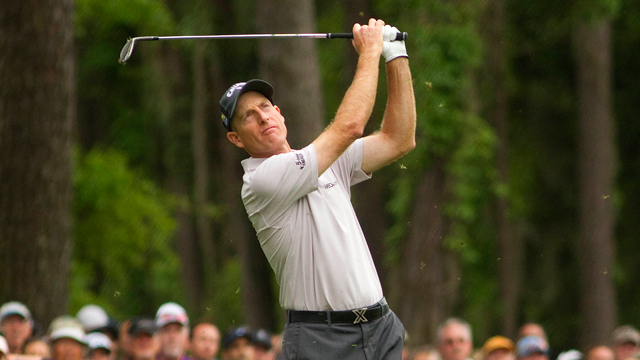NEWS
Furyk's lesson: It's his game, not his swing

Jim Furyk's unorthodox swing may not be particularly "pretty" when compared to a classic swing: the likes of, say, a Bobby Jones or a Ben Hogan. But here's the thing -- it's been pretty effective for Furyk, who won Sunday's RBC Heritage playoff at Harbour Town. The win was his 17th Tour victory -- and his resume includes the 2003 U.S. Open and 2010 Tour Championship, in addition to nine Ryder Cup teams.
And that's what's so fascinating about the game of golf, according to PGA Professional Rodd Slater of Two Rivers Golf Club in Dakota Dunes, S.D. As long as you can strike the ball consistently with a repeatable motion, your swing can loop and swirl all it wants.
MORE LESSONS: Three tips to improve your half-swing shots
"You wouldn't want to try to coach Jim Furyk's swing to somebody," Slater said. "But it's his way and his way works. It may not work for everybody, but he's figured out a way to get the club back to the ball in a way that sends it towards the target.
"When he does that, the ball flies similarly and he builds his game upon that. With him, it may not look conventional, but it's his way. You don't necessarily correct what works just because it doesn't appear conventionally sound."
Part of that is how Furyk learned the game. He didn't play a full round of golf until his 12th birthday, and his only coach throughout his career has been his father, Mike, a former club professional who decided early on to leave Jim's unusual swing alone.
"His swing is indicative of a lot of kids who grow up and figure out how to play golf on their own," Slater said. "They don't necessarily go to a teaching pro or someone with a lot of experience teaching golf. They figure out a way to get the golf ball to go where they want to. And that really is the whole idea of the game."
While Furyk's unorthodox swing raises some eyebrows, he's hardly the only player on Tour with an atypical swing, Slater said. But every pro at that level have two things in common -- they can control their ball flight and successfully repeat their own swing under the pressures of tournament golf.
[wide_search_instructor]
Besides, the swing is only a portion of what makes Furyk and others successful.
"Jim is one of the best drivers on the Tour," Slater said. "What won today was his 11 birdies in 20 holes, including two birdies on two playoff holes. It's phenomenal. His game was through the charts today.
"It was really good to see him back today. He's a great competitor and if he's playing like that, he'll be a threat to win or compete in the remaining majors."
That's because Furyk can get the clubhead where he wants it at impact, even if it's not necessarily how a teaching pro would draw it up. The lesson to learn from that is simple: If your own swing isn't "picture perfect" but you can replicate it and control the ball, don't fuss with trying to make it match what you see someone else doing on television or in a magazine.
Instead, concentrate on the whole package -- keeping the ball in the fairway, distance control, short game and putting -- because in the long run, that's what will lower your scores. You don't get extra credit for a swing that draws raves in the clubhouse.
"These Tour players get to where they're at because of their games, not their swings," Slater said. "The swing is only a part of that. It's a player who improves their entire game over the course of a lifetime -- like Jim Furyk has -- to where he can make 11 birdies in 20 holes and do that consistently over four days, including a playoff. That's what won him the tournament, not his golf swing.
"Guys who have great games are the ones who rise to the top as far as their careers go. Their games are sound. They may not be on every week, but because of all of the things that go into playing the game -- the competitive nature, the ability to control distance and so on -- that's what separates them."
Your own swing may never rival Jones or Hogan. In fact, you may never be able to hit the perfect draw or fade. That's not nearly as important as feeling comfortable with the swing you have, and being able to know where the ball's going most of the time. Just ask RBC Heritage champ Jim Furyk.